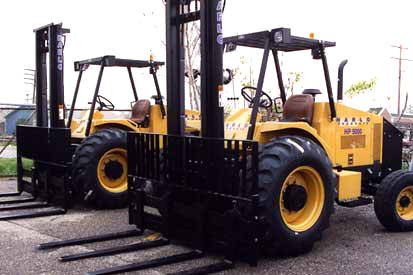 Although the conventional types of counterbalanced forklifts fall into different ITA classifications (class 1, 4 &5) than the rough terrain vertical mast (RTVM – class 7), did you know that if you are an IVES Certified Trainer on the conventional units you also have the knowledge and ability to train operators of RTVM units? In fact, we recommend you utilize our regular Counterbalanced Forklift Operator Reference Manual to deliver your training on RTVM as it contains all of the basic operational theory information that is also applicable to RTVM units which in theory, are really just larger versions of conventional counterbalanced machines.
Although the conventional types of counterbalanced forklifts fall into different ITA classifications (class 1, 4 &5) than the rough terrain vertical mast (RTVM – class 7), did you know that if you are an IVES Certified Trainer on the conventional units you also have the knowledge and ability to train operators of RTVM units? In fact, we recommend you utilize our regular Counterbalanced Forklift Operator Reference Manual to deliver your training on RTVM as it contains all of the basic operational theory information that is also applicable to RTVM units which in theory, are really just larger versions of conventional counterbalanced machines.
That being said, make sure you get yourself thoroughly familiarized with the RTVM unit you will use in your training by reading the manufacturer’s operating manual and adopting any specific safety/operational information into your training class, just like you should do for any training you do. In doing so, you will find that all of the basic principles as they relate to stability and capacity apply across both conventional and RTVM forklifts but that there are several differences relating to the components and operating controls. For example, some basic but significant differences between conventional and RTVM units are:
- Capacity/size/weight – Since RTVM units are made to handle heavier loads, they are usually quite a bit larger and heavier. This means they need more space to operate in and must always remain on a driving surface that provides substantial support. Alert your operators to be wary of soft, muddy ground as well as bridges or similar structures.
- Tires – They always use pneumatic (air filled) on RTVMs and occasionally, ballast (liquid filled) or foam filled tires are used. If they are ballast type tires, there should be a decal on the machine and/or a warning in the manual alerting you to this. Ballast tires should only be filled/serviced by qualified personnel.
- Forks – Many times, the forks on RTVM machines are shaft mounted which means there is an “eye” at the top shank that fits onto a shaft and they are not attached to the carriage at the lower end of the back of the fork. This means that the bottom of the fork can swing up and away from the carriage while backing out from a load causing the tips to swing upward as well. Operators have to be sure that the forks get a clean exit when backing out of loads.Also, because of the heavy load the forks on RTVMs are made to handle, the blades can be quite a lot thicker than those found on conventional units. Operators must consider this when assessing how much room is available for the forks before engaging loads.
- Mast – Since RTVM units are not designed for indoor warehouse applications, the mast is usually not designed with any free lift. This means that as soon as the forks begin to rise, the second stage of the mast starts to rise as well.
- Capacity Restrictions – on some RTVM units, the amount of weight that can be lifted depends on how high the load is lifted. For example, a unit with a maximum capacity of 10,000 lbs may only be able to lift that much weight up to a certain height, let’s say 12 feet. From that point, it may only be able to lift 8,000 lbs up to 16 feet and so on.
- Controls – The basic controls in the cab of an RTVM forklift are more or less the same as they are in conventional counterbalanced units but how they are laid out can vary quite a bit, which could throw an operator off. You would be wise to consider that and take some time to familiarize yourself (and your operators) with the control layout. Occasionally, you may come across controls for parts/systems on RTVMs that you would never find on conventional units, like air-assist brakes, four wheel drive/steer options or individual lift/lower levers for each stage of the mast.
These are just a few examples of how RTVM units may differ from conventional counterbalanced units. Remember, the items described above and possibly many more are all listed and explained in the manufacturer’s equipment-specific manual so be sure to check it and let your operators know to do the same!
Rob Vetter
Director of Training
IVES Training Group
Did you enjoy this article? Sign up for our newsletter to receive more like this!